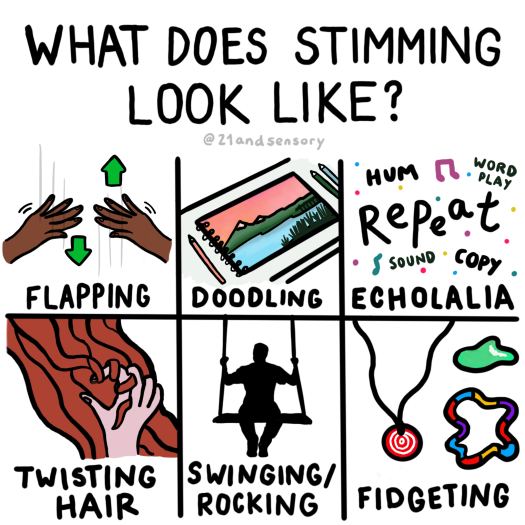Let’s Talk About Stimming
Today we're going to talk about stimming, which is a short term for a self-stimulatory behavior, which often looks like repetitive body movements or repetitive movement of objects. Stimming often occurs in autistic people as well as people with other developmental disabilities or can even occur in neurotypical people as well. Stimming can be as little as biting your nails or tapping your feet or fingers but it can also look like other less socially acceptable behaviors such as hand flapping, rocking side to side, or making noises. While stimming is not understood by the scientific community, there are some theories about the purpose of it and autistic adults like myself can give others an idea of why people do this.
Some theories suggest stimming may produce dopamine which can increase pleasure sensations and therefore be a comforting mechanism during times of stress or if feeling overwhelmed. They can also be used by an individual to counteract sensory overstimulation or to meet Sensory needs. Autistic people of any age may stem in response to certain emotions such as excitement, happiness, stress, boredom, fear, and anxiety.
There are different types of stimming based on the various senses. Some examples of auditory stimming that uses the person's sense of sound may include making vocal sounds such as humming, grunting, or even screaming. Another example of auditory stims can be tapping on objects, covering ears, or repetitive speech such as repeating a song or movie lines. Some examples of tactile stimming which uses a person's sense of touch can include rubbing or scratching and hand movements such as opening and closing fists. Some examples of visual stimming can be staring at certain objects, repetitive blinking, turning lights on and off, or object placement search as lining things In a row. There are also vestibular stimming behaviors which use a person's sense of movement and balance. Some examples of this are rocking back and forth, spinning, jumping or pacing. There are also olfactory and taste stimming behaviors which can include smelling people or objects or tasting things.
Now there are several products aimed toward people who stim and recently there have been products made for stimming that have gone mainstream which is amazing. Objects like fidget spinners, fidget cubes, Rubik’s cubes, slime, kinetic sand, and various other items that can be used for stimming purposes. These items are all wonderful for normalizing stimming behavior and providing accommodations for people who would benefit from these objects. Even neurotypical people benefit from these stimming objects because it can help relieve anxiety and stress.
While stimming is not usually a problematic behavior, a person can have higher risk behaviors such as banging their heads on objects or hitting themselves. However, these behaviors, while repetitive, are more often behaviors used to communicate nonverbally, rather than being a stim. One of the problems that may arise for a stimming individual could be the social implications of them having a behavior that may not be socially acceptable. This often leads to people trying to stop somebody from stimming, however stopping a stimming behavior can lead to adverse problems for that person. Trying to curb stimming behavior can lead to that person having low self-esteem and may lead to possible meltdowns and mental health issues for that person. There is a reason for the stim, and while it might feel strange and awkward to the person around them, they are doing it most likely to meet a need that they have.
If a stimming behavior for some reason interferes with a person's ability to learn, or it becomes disruptive for other people, there are ways to replace stimming behaviors with ones that may not cause these problems. The key is to find out the need behind the stimming behavior so that a replacement behavior will be able to meet that same need. For example, a student might need a vestibular stim to concentrate to the learning material, and so they rock back and forth , but maybe it is found that that behavior is disruptive to other students, so then the teacher might provide that student with a wiggle chair, or a chair that enables them to rock back and forth in it without being disruptive to those around them.
The most important thing about stimming that I would want neurotypical people to know is that we do not do it to make you feel uncomfortable but that we are simply fulfilling a need that we have. A lot of people's first instinct is to criticize and try to stop the behavior, without thinking about that individual's reasoning for that behavior. For example, that person hand flapping at the doctor's office maybe doing that to prevent an oncoming meltdown. Maybe they are already overwhelmed from things that have happened throughout the day, but they just need to get through this doctor's appointment and in order to do that, they hand flap. Now imagine if the doctor or even another patient looks at them with criticism and tells them to stop. That person then might have a meltdown right there because the person who asked them to stop did not think about the implications it might have.
Overall community awareness is what we are looking to achieve with our programming here at spark project collective. We want to help the community around autistic individuals be more sensitive to the needs of autistic individuals which can in general create a more accepting, diverse and welcoming society.
